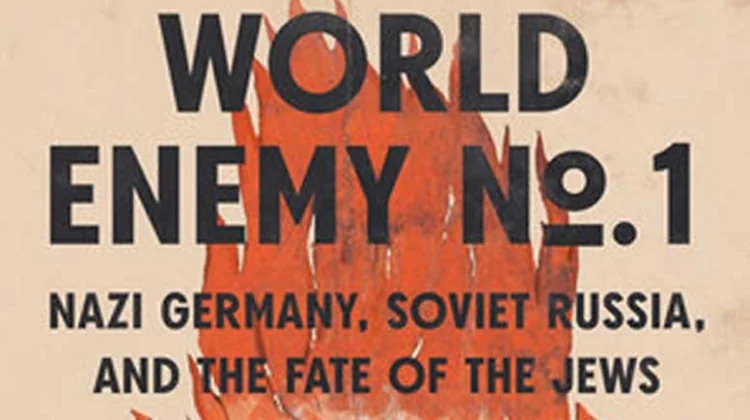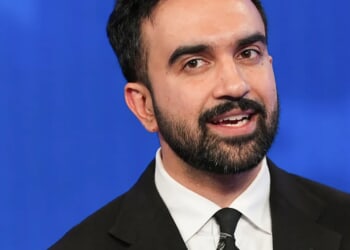
[Order Michael Finch’s new book, A Time to Stand: HERE. Prof. Jason Hill calls it “an aesthetic and political tour de force.”]
World Enemy No. 1: Nazi Germany, Soviet Russia, and the Fate of the Jews is a new book that offers a daring interpretation of World War II. Author Jochen Hellbeck is Distinguished Professor of History at Rutgers University. German-born Hellbeck’s previous works include Stalingrad: The City that Defeated the Third Reich, and Revolution on My Mind: Writing a Diary Under Stalin. Hellbeck’s father, a 17-year-old draftee, fought briefly for Nazi Germany, before being injured on the Eastern Front. His maternal grandfather ran a factory that used Russian forced laborers. Penguin Press will release World Enemy No. 1 in the US on October 21, 2025. It is 560 pages, inclusive of black-and-white illustrations, maps, a bibliography, and an index.
About the book, historian Yuri Slezkine says, “It takes courage, as well as tremendous talent and dedication, to tell this story with so much empathy, eloquence, and insight … a magnificent memorial to both the victims and the victors.” Journalist Keith Gessen says that the book “breaks new ground by shifting the focus from some primordial German hatred of Jews to the fierce political competition between Hitler’s fascism and Soviet Communism, which Hitler re-coded as ‘Jewish Bolshevism.’ Hellbeck reminds us of the original wording of Martin Niemoller’s warning, ‘first they came for the Communists’ – for the people they deemed most threatening to their political project – and then they came for everybody else.” Historian Paul Hanebrink says the book is “essential reading … Hellbeck masterfully explains what made World War II on the Eastern Front so destructive and why this matters today. A tour de force of historical writing.” Historian Ron Suny says, “Without excusing the pathologies and atrocities of the Stalinist system, Hellbeck unfolds the tragic tale of how a despotic regime saved the democratic world.”
In World Enemy No. 1, Hellbeck focuses on Nazi Germany’s obsession with Soviet Communism as Nazi Germany’s most formidable and diabolical racial, ideological, and military enemy. Slavs were subhumans according to Nazi ideology. The Nazi Generalplan Ost slated Slavs for torture and ultimate genocide, with a remnant retained as slaves. Especially dangerous and evil were “Judeo-Communists,” or Soviet Jews who were conflated with Communist ideology. Hellbeck demonstrates this conflation with an anecdote. In 1928, Carin Goering, wife of top Nazi Hermann Goering, was observing the German Parliament. Communist deputies were wearing red stars. Carin wrote that she was disgusted by the “Star of David” the Communists wore. To Mrs. Goering, the red star of Communism and the Star of David were one and the same.
Jews were mass murdered and all but wiped out. The remaining Soviet population was murdered more slowly and not quite as thoroughly, but often no less viciously. There are various estimates of how many Soviet citizens were killed by the Nazis; Hellbeck accepts the figure of twenty-six million. The USSR did not suffer the worst of all nations per capita. By one estimate, Belarus (which was then divided between the USSR and Poland) suffered the worst losses per capita, with more than 25% of its population dying. Poland suffered the second worst losses per capita, with a loss of an estimated 17%. Such estimates can never be exact.
Publicity materials for Hellbeck’s book praise it for its unique approach. For this reader, World Enemy No. 1 was not shocking in the novelty of the material it presents. Given my parents’ roots in Eastern Europe, my reading, and my travel there, I was not surprised to read of Nazism’s stereotyping of Slavs as subhuman. I was not surprised to read that the first human beings that the Nazis murdered with Zyklon B were Soviet POWs and Poles. I was not surprised to read that the Nazis murdered, often by starvation, over three million Soviet POWS. Other POWs were locked in buildings and the buildings set on fire. I was not surprised to read of the ferocity with which the Red Army fought the Germans. In Poland in the 1980s, I was present at commemorative events for the Red Army’s “liberation” of Poland. As the promotional materials for this book state, though, many Western European and American readers may be quite surprised by this book.
I loved this book. “Love” is a strange word to use for a book that presents the stuff of nightmares. I loved this book because it is well-written. I’m a slow reader and I zipped through the book, turning page after well-written page, even after my daily allotted reading time had expired. Conversely, I often had to pause for a moment or two to cry and to pray. Hellbeck’s style is cerebral and cool. Unlike some authors – even academic ones – who exploit atrocity to engage in ethnic hate-mongering, Hellbeck never invites the reader to conclude that Germans or Russians are uniquely evil. Even with Hellbeck’s style, the material in this book made me cry, repeatedly.
Hellbeck paints the big, historical canvas in a few quick strokes, and then he fills in unforgettable details from his readings of a massive amount of material in a variety of genres, including diaries and letters from relatively obscure people. We learn not just about the Nazis’ hanging famous partisan heroine “Tanya,” we also learn that local villagers, angry at Tanya for attempting to carry out an ordered scorched earth policy, betrayed her to the Germans and mistreated her. Hellbeck’s approach renders his book cinematic.
It took courage for Hellbeck to write this book, for three reasons. He took on an almost impossible task, of praising individual heroes while acknowledging, at every turn, the monstrosity of the Stalin regime. In addition to praising heroes, Hellbeck cites what he believes to be a noble aspiration that Communists at least paid lip service to, that is, a “universalist” “humanism.” The best people in the USSR fighting against the Nazis believed that they were fighting for “humanism” and “universalism” untainted by the racism of the Nazis. In this idealistic formulation, the Soviet system didn’t care if you were Russian or Ukrainian, Christian or Jewish. We know that the USSR didn’t live up to this ideal, but Hellbeck insists that some frontline heroes did.
No potential reader of this book should fear that it whitewashes Stalinist crimes. For just one example, Hellbeck recounts the Soviet massacre of Polish army officers at Katyn in gruesome detail, and also records how the Soviets and even their Allies, Churchill and Roosevelt, attributed that crime to Nazis. He addresses the grisly 1941 NKVD prison massacres and their impact on antisemitism. At the same time, as any honest historian must, he foregrounds the Red Army’s key role in Nazism’s ultimate defeat.
He reports on the unfathomable suffering of Soviet citizens who were enslaved in Germany by the Nazis. And then he tells you that when these enslaved Slavs and others returned to the USSR, their government treated them abominably. “What did you do to survive? Did you collaborate? Were you a Nazi whore?” they were asked, and even imprisoned. Again, Hellbeck is “just the facts” author. He acknowledges the sadistic criminality of Stalin’s regime, while praising the heroes who lived up to the putative ideals of that regime. Hellbeck leaves it to the reader to make sense of, as Ron Suny says, “the tragic tale of how a despotic regime saved the democratic world.”
There’s another reason Hellbeck deserves praise for his courage. When I was researching my own book, Bieganski, I asked a very well-educated Jewish American informant if he was aware of any non-Jewish prisoners at Auschwitz. He was not. His lack of awareness was repeated among my informants, who were often university graduate students and even professors. They simply did not know that Nazis demonized, tortured, or murdered anyone except Jews. Similarly, semester after semester, I would ask my new students, “What was the first group Nazis mass murdered as part of an organized program? And, in fact, the Nazis continued to mass murder these people even after surrender?” None of my students ever knew the answer, which is, of course, handicapped people, in Aktion T4. When I informed my students of this, they were utterly confused. They had no idea why Nazis might mass murder handicapped people. In fact, as Richard Weikart has demonstrated in his work, regarding handicapped people as “life unworthy of life” is entirely consistent with Nazism’s social-Darwinism-inspired worldview. This lack of awareness is not limited to my students. In a 1989 New York Times op ed, journalist Leon Wieseltier wrote that non-Jews who suffered under the Nazis “died a death invented for the Jews. They were the victims of a ‘solution’ designed for others.”
The problem is that the horror of Nazism is a commodity, and commodities are always contested. As works like Peter Novick’s The Holocaust in American Life show, the uniqueness of Jewish suffering has often been erased or underplayed. That has been true in America; it’s especially true in Soviet bloc countries, that often dubbed Nazism’s victims as “victims of fascism” rather than as Jews. Since Jewish suffering has been denied or downplayed, Jews often commit themselves to focusing on it.
The Nazis murdered tens of millions, many non-Jewish. Jewish suffering is unique because of the per capita death toll. The Nazis murdered an estimated 66% of European Jews, and 33% of all the Jews in the world. To this day, the Jewish population has not rebounded. Poland had been a world center of Jewish culture. The Nazis murdered 90% of Poland’s Jews. There were three million Jews in pre-war Poland. There are 17,000 Jews in Poland today.
All of the above is true, but there is another truth. The Nazis were racist against Slavs. To acknowledge this, as Hellbeck does, and to cite the importance of this history in understanding the world, as Hellbeck does, is not an attempt to diminish the Holocaust.
There’s another reason Hellbeck is courageous to take on this material. Nazis explicitly attempted to justify their mass murder of Jews with a conflation of Jewish identity and Communism. Antisemites today follow in the Nazis’ footsteps. Discussion of this topic is a landmine because Jews were disproportionately represented in Communism at times and in places. In the 1930s and 40s in the US, Jews made up almost 50% of American Communists. In post-war Poland, Jews were prominent in the Communist takeover and violent suppression of Polish society. As is often noted, Jews were attracted to Communism at least partly because it promised a world without antisemitism. But a minority of Jews were Communists and a minority of Communists were Jews. Stalin, Lenin, Dzierzynski, Beria, and Molotov, for example, were not Jewish. The USSR’s persecution of Jews proved that Communism could not keep its promise of a world without antisemitism. In Poland, in 1968, Communists finished the job Nazis started; they drove Poland’s remaining Jews out of the country. In any case, to conflate an ethnic identity with an ideology or a behavior, and to use that conflation as justification for hatred and even genocide, is evil and irrational.
To support his thesis in World Enemy No. 1, Hellbeck marshals a massive amount of material from a variety of sources. The following summary sketch can offer only a few highlights from each chapter.
In the introduction, we learn that Nazis justified the massacre of Kiev’s Jews at Babi Yar thus: “The Jews, without exception, served Soviet Bolshevism.” “Bolshevism was one of Hitler’s primary obsessions and the catalyst to provoke Nazi Germany to mount a war of extermination unprecedented in world history,” Hellbeck writes. As soon as Nazis came to power, they imprisoned 100,000 German Communists in concentration camps. “Everything I undertake is directed against Russia,” Hitler said. “The end of the Jews is also the end of Bolshevism,” claimed Der Sturmer. When the Red Army defeated “superior” Germans, Goebbels cited “primitive Slavic animality organized into resistance by wild [Jewish] terror … There are living beings that are extremely resilient because they are so inferior. A street dog is more resilient than a highly bred German shepherd … a rat is more resilient than a pet.” As the Red Army advanced on Germany, “The Russian displaced the Jew or Jewish Bolshevik as the embodiment of monstrous, Asiatic evil.”
Chapter One, “A Front Against Bolshevism,” quoting ordinary Germans’ own words, addresses “what turned Germans into Nazis.” “Anti-Bolshevism energized and shaped the Nazi Party.” Other Western powers also hated and feared the new Soviet state. (This reader notes that there was good reason to hate and fear the new Soviet state.) “Kill the Bolshie; kiss the Hun,” said Churchill. Anti-Communism was instrumentalized to serve the Nazis’ rise. “The politics of fear worked,” Hellbeck reports. In 1928, Nazis received 2.6% of the vote. On March 5, 1933, they received 43.9%. On March 13, Himmler ordered the creation of Dachau. Prisoner number one was a German student, a Communist. Nazis attributed “racial” characteristics to Communists, even those who were not Jewish. One could distinguish Communists by their “semi-animal” faces.
Chapter Two is titled “Swastika and Soviet Star.” Soviets recognized the threat that Hitler’s rise posed to the USSR. Stalin wanted to stay out of the inevitable war as long as possible. Throughout the thirties, Nazi Germany and the USSR and other Communists criticized each other. The West was not as concerned about the Nazis sending Communists to concentration camps as it should have been. Willi Munzenberg, a German Communist, published The Brown Book on the Reichstag Fire and Hitler Terror, “the first major indictment of Nazism.” Nazis burned Communist books, published articles conflating Communist Party membership with racist, subhuman traits, and opened hatemongering museum shows. One used imagery from the Biblical book of Revelation. “The beast arose from the abyss and revealed itself in Russia … the dragon is unchained. May he who stands with God take up the sword!” On a more earthbound level, Hitler salivated over dreamed-of possession of Ukraine’s wheat fields. British policy-makers deemed Communism a greater threat than fascism. In spite of the obvious threat from Germany, Stalin had “several thousand” Red Army officers executed on “patently false” charges. Dr. Mamlock, a Soviet film, was “the first movie to inform Americans of the Nazis’ violent persecution of the Jews.” It was banned in Britain to avoid “antagonizing” Germany. The Hitler-Stalin pact fulfilled both evil men’s temporary needs.
Chapter Three, “Crossing the Rubicon,” opens with a brief but honest discussion of the Nazi invasion of Poland. Poland’s fate is often silenced or underplayed by Westerners. Poles are often mocked or criticized for citing their country’s crucifixion by Nazi Germany. Not so with Hellbeck. The Wehrmacht’s “goal was to eradicate any trace of the Polish army, the Polish state, and indeed Polishness itself.” “Destruction of Poland a priority,” ordered Hitler. “Act brutally.” Poles were “more like animals than human beings.” Reinhard Heydrich had prepared lists of 61,000 names, primarily “priests and teachers.” These were shot. “Ethnic Poles, not Jews, were the primary group targeted for execution by the German commandos … German violence against Jews between 1939 and 1941 remained of a lesser scope compared to the mass murder of ethnic Poles.” Poles were driven from their homes, homes that were handed over to incoming Germans. Nazis considered sending Jews to Madagascar. In their zone, Soviets packed hundreds of thousands of Poles into train cars and sent them to camps in the east. They massacred tens of thousands of officers in Katyn.
Operation Barbarossa soldiers were told that Jewish Bolsheviks were “the embodiment of the infernal.” Propaganda depicted Red Army soldiers as “a bestial mass stripped of all humanity.” As Germans advanced, Beria, fearing collaboration, ordered the NKVD prison massacres. An estimated 100,000 prisoners were killed, often in brutal fashion. Locals sometimes thought of advancing Germans as liberators from Soviet rule. Given popular associations of Jews with Communism, an association encouraged by Nazis, pogroms broke out. At this point, “Heydrich did not call for the extermination of all Jews, nor did he call for killing Jewish officials on racial grounds. Rather, the Jewish officials he targeted were singled out as representatives of Bolshevism.” This did not last. It became “general policy” to “shoot all Jews.” This was carried out unevenly. Soon almost all Jews in Baltic states were dead, whereas most Polish Jews were still alive. Hellbeck quotes a German police administrator telling his wife that he shot “without hesitation” many women, children, and infants.
Chapter Four, “A Violence Shaking Europe,” reports that the Nazis began persecuting Communists throughout occupied Europe. Nazi occupiers in Western Europe argued that in their territories “Polish methods” – that is the terror they unleashed in occupied Poland – was too harsh. Some German citizens publicly defended Jews when the yellow star was mandated. Goebbels initiated more antisemitic propaganda to counteract this. Even Himmler differentiated, for a time, between better treatment for German Jews than for Soviet Jews. “For the time being, Himmler ordered a halt to the killing of Jews deported from Germany.” After America joined the war, Hitler decided that the Jews were behind it. He wanted all Jews killed.
Chapter Five “Jews and Bolsheviks, Step Forward!” describes the horrors of German camps for Soviet POWs, where dogs tore apart Jewish inmates and non-Jewish inmates were systematically starved to death. Any incidence of cannibalism was exploited by German propagandists to support their idea of Russians as non-human animals. The Balts had suffered badly under the Soviets and many were willing to collaborate with Nazis. Western Ukrainians were more antisemitic than those in the east, who had lived under the Soviet system. Various tortures are described, including villagers clubbing Jews to death. Jews and POWs were herded into a camp so crowded that prisoners could not sit down. Germans gave them salted fish to eat – but no water. Prisoners who attempted to drink from a pond were shot. Underground cells formed, counterfeiting identity documents. Nazis hanged resisters like the Jewish Maria Bruskina and disseminated photos of the hanging. Such propaganda inspired others to act. Those in the resistance determined to “die like a human being, not like an animal.” “The rescue of the Jews from Minsk was for the most part undertaken by men and women who were involved with Communist underground networks.” German Jews were sent to Minsk. Nazis allotted these “Hamburg Jews” larger food rations and less work than eastern Jews because they were “human beings who come from our culture sphere.” They were not the “native bestial hordes” of Slavic nations. “The German Jews, for their part, looked down on the locals as ‘Easterners.’” Heydrich flew to Minsk to stop this differentiation, and to ensure the massacre of all the Jews. “Only a handful survived.”
In Chapter Six, “Moscow Strikes Back,” Hellbeck reports that “Stalin was stunned” by Operation Barbarossa. Hellbeck argues that the USSR maintained extensive and accurate records of Nazi war crimes on Soviet territory. “We must exterminate the Slavic peoples – Russians, Poles, Czechs, Slovaks, Bulgarians, Ukrainians, Belorussians,” Hitler is quoted as saying. Surviving Slavs would be “human machines, human animals, subhumans living in stalls.”
Soviet propaganda about Nazi crimes against Jews fluctuated. At times, the Soviets acknowledged Nazism’s focus on a genocide of Jews. At other times, such focus was deemed unhelpful. As was the case in the US as well – see the previously mentioned Novick book as well as the documentary America and the Holocaust: Deceit and Indifference – Soviet propagandists might avoid mentioning the different treatment of Jews because they feared antisemitism in their own population, and they did not want to give antisemites an excuse to abandon the war as a “Jewish war.”
There were other reasons for downplaying Jewish victimization. Communists wanted to promote an image of the enemy as “fascism,” rather than genocidal antisemitism. Hellbeck cites “the Soviet belief in internationalism” and “multiethnic unity.” And he reports that “Soviet Jewish activists themselves contributed to this obfuscation.” Having no republic of their own to claim, they were the most committed to Soviet unity. “To rid themselves of negative ascriptions of Jewishness as parochial or self-interested, they sought to represent Soviet Jewish suffering as Soviet suffering write large.”
The outside world paid scant attention to the suffering of Soviet POWs, in spite of Vyacheslav Molotov’s direct appeal for more attention to the matter. Goebbels noticed this and presented Soviet POW and “Molotov’s son” to the world to refute Molotov’s claim of mistreatment. The New York Times presented this story uncritically. In fact, Molotov had no son. Goebbels hoodwinked his audience. “Well into fall 1941, Western commentators gave more overage and credibility to Goebbels than to his Soviet opponents.”
Hellbeck’s book is, inter alia, a salute to Soviet Jewish author Ilya Ehrenburg. Ehrenburg wrote prolifically during the war. He used captured German diaries and letters. In one letter, a German officer describes four captured eighteen-year-old Russian “beauties” whom he eagerly whipped to make “them more compliant.” Ehrenburg’s exhaustive works, Hellbeck argues, were accurate, not unreliable propaganda. Hellbeck says that he can confirm this through archival material. The Lend-Lease program helped the USSR; the USSR helped the West with Ehrenburg’s accurate picture of Nazism’s crimes.
Chapter Seven, “Enslavement,” quotes Hitler. Slavs are a “mass of born slaves that cries out for a master.” Goebbels said that Russians were “not a people, but an accumulation of dull animals.” Hellbeck reviews Generalplan Ost.
When the Third Reich needed workers, it turned to Slavs in occupied areas. They were sent to farms and factories in Germany, where they were treated much more harshly than workers from occupied nations in Western Europe. Slavs might be stripped naked and lined up for inspection by potential German buyers. “They looked us over from all sides, like cattle,” said one survivor. Hellbeck also covers the recruitment of some occupied people into fighting forces.
As the war went on, partisan activity increased. Germans required local women and children to demine areas near partisan camps; they recorded how many children were “blown to pieces” in these procedures. Villages suspected of supporting partisans were burned to the ground. In just one “pacification” operation, at least 20,000 civilians were murdered. Nazi “dead zones” “comprised three quarters of the arable land in military-occupied eastern Belorussia.” As the Red Army advanced through Ukraine, Himmler ordered that “no person, no head of livestock, no hundredweight of grain, no rail remains behind.” Nazis looted households, placed their loot on trains, and, after departure, a rear guard dismantled train tracks.
Himmler’s October, 1943, speeches in occupied Poznan, Poland, are “best remembered for the section in which Himmler spoke about the annihilation of the Jews,” but at that point he thought of the Final Solution as a “settled matter.” The war against the “Asiatic,” “Russian” enemy ground on. “Never forget you are dealing with a beast,” he said. “If while building a tank ditch, 10,000 Russian women die from weakness or not, that interests me only insofar as the tank ditch is built for Germany.”
Chapter Eight “Liberation.” The Nazis used their discovery of mass graves at Katyn to produce anti-Soviet propaganda. The Allies insisted, falsely, that Nazis had done the killing. In Aktion 1005, Nazis attempted to hide evidence of their own mass killing. Prisoners were chained and forced to exhume bodies, burn them, and run the bones through crushing machines. As Germans retreated, advancing Red Army soldiers encountered evidence of atrocity. This stirred desires for vengeance. A debate ensued. Some argued for, others against, a vengeful attitude.
Chapter Nine is titled “Here She Is, Accursed Germany!” D-Day opened a second front. Captured German soldiers provided ample evidence, sometimes including their own photographs, of war crimes. “Soviet efforts to prosecute German war criminals predated those of their western Allies and proceeded with greater zeal … as early as 1942, Soviet leaders proposed the formation of an international tribunal to try Nazi perpetrators.” The December 14, 1943 Kharkov trial was “the first Nazi war crimes tribunal held by any Allied power.” One defendant characterized “himself as a ‘victim’ of orders issued by the German government.”
Ilya Ehrenburg insisted that an attitude of vengeance would not help justice. This in spite of his access to Germans’ letters and diaries full of accounts of atrocities, for example this, from a German sergeant. “My nerves are strong,” he wrote in a letter about his role in “harsh measures.” But, “on the other hand, for a year and a half, my life was one of complete pleasure: the cooking was good, vodka, beer, girls, walks.”
As the Red Army advanced, “No region between the Memel River and Upper Silesia remained untouched by Soviet soldiers marauding, raping, and murdering.” Their deeds were “extensively documented” by both German and Russian observers. A soldier wrote to a friend, “We are retaliating for everything, for our wounds … for the children and the elderly, for our girls.” A Jewish sergeant wrote, “If you knew what I saw as I walked across the fields of our dear Belarus and Lithuania, you’d understand … We came here to take revenge, and if you knew how we took revenge, you’d agree that the Germans will never dare to invade us again.” A Moldovan wrote, “Let the Germans now experience what they inflicted on other peoples.” Other Soviet soldiers, in their letters and diaries, struggled with the concept of revenge, resisted exacting revenge, and protested when others did so. Stalin threatened rapists with execution. Some were executed in the field for the crime. In other cases, soldiers killed superiors who attempted to discipline them.
Germans, when hearing accounts of Red Army atrocities, came to believe that these accounts proved their own racist notions. Even though Nazis had murdered the majority of Europe’s Jews, Nazi propaganda posters depicted Red Army soldiers as Jewish stereotypes. To avoid mistreatment by the Red Army, many Germans committed suicide. German soldiers were surrendering to advancing Allied troops coming from the west, but fighting fiercely against Red Army soldiers. Allied soldiers also committed atrocities and rapes, often after first-hand exposure to Nazi atrocities.
Concentration camp personnel attempted to hide their crimes by sending inmates on forced marches that often resulted in death. As the war wound down, four hundred Red Army officers broke out of Mauthausen. The camp commandant called on the local population to kill them all. Only eleven officers survived the locals’ “bloodlust.” “Killing sprees like this swept across Germany … Hitler Youth banded together to shoot ‘red pigs.’” Foreign workers, the majority Soviet citizens, were also shot en masse even as American troops approached.
Chapter Ten “Erasure.” The four prosecuting nations at Nuremburg differed markedly. Soviet prosecutor Roman Rudenko, differing from the Americans’ approach, indicted all Germans. He quoted a Nazi youth song:
The world may lie in ruins
Why the devil should we care
We’ll keep on marching forward
even if everything falls apart
for today, Germany is ours
and tomorrow, the world.
Francesc Boix, a Catalan Mauthausen survivor, described how Russians were treated in the camp. “Not even a month would suffice for him to tell the court everything he had witnessed.” Boix had photos of skeletal and naked Soviet POWs lined up in rows. That photo is here.
The USSR was the only power to bring Jews to the stand at Nuremburg. One Jewish witness planned to smuggle a pistol into the court to kill Goering. Ehrenburg talked him out of it.
Winston Churchill’s “Iron Curtain” speech, of March, 1946, changed things, according to Hellbeck. Stalin responded, and the “duel” “shook the Nuremburg courtroom.” “Public sentiment in the US was turning staunchly anti-Soviet.” War crimes trials continued in the USSR. “Soviet readers and spectators in 1946 were presented with more detailed knowledge about the Germa mass murder of Jews than audiences anywhere else in the world.” Jewish voices, though, “would soon be drowned out” in the USSR. Politics around the USSR’s changing stance toward Israel interfered with further discussion. “The Kremlin’s shrill anti-Zionism silenced the memory of Soviet Jewish suffering.” Nikita Krushchev didn’t want it to seem that “only the Jews were the victims of fascist atrocities.” Though Soviets did downplay the uniqueness of the Final Solution, “Communist states were more determined than Western states to document Nazi atrocities.” Auschwitz and Buchenwald memorials, in the Soviet bloc, opened in 1947 and were planned in 1950, respectively. In contrast, Germany did not open a concentration camp memorial until Dachau in 1965. “As late as 1966,” former Nazis constituted the majority in the West German Ministry of Justice and Federal Criminal Police Office.
The USHMM distorts history by underplaying the role of the USSR, and Hitler’s obsession with Communism. It misquotes Martin Niemoller, who did not begin with “socialists,” but, rather, “Communists.” “The Nazis rose to power and generated enormous backing across Germany and throughout Europe on the strength of their staunchly anti-Communist politics and their ability to fuse Communists and Jews.”
Hellbeck closes with comments on how World War II history affects contemporary politics.
Inevitably, Hellbeck is asked the impossible question. Who was worse, Hitler or Stalin? Hellbeck replies that average Soviets were often inspired by the putative Soviet ideal of humanistic internationalism – that is, the idea that all people are equal. That ideal pushed them to perform heroically under hellish conditions. Germans, on the other hand, were driven by the vile Nazi ideal of racism. Some humans are valuable; other humans are animalistic. Given their respective moral frameworks, some Soviets criticized other Soviets who committed atrocities against Germans, during the Red Army rapes, for example. Germans, on the other hand, Hellbeck says, in their diaries and letters, do not criticize atrocities, they justify them with the ideal of racism.
Hellbeck says, further, that the Soviets who lived under both Stalin and Hitler at first might greet advancing Nazis, but came to despise them. He quotes a Ukrainian joke from 1942. “What did Hitler mange to accomplish in just one year that Stalin couldn’t in twenty-four? Getting us to like Soviet rule.”
Danusha V. Goska is the author of God through Binoculars: A Hitchhiker at a Monastery.
















